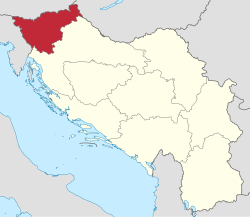| Drava Banovina Dravska banovina Дравска бановина | |||||||||||||
|---|---|---|---|---|---|---|---|---|---|---|---|---|---|
| Banovina of the Kingdom of Yugoslavia | |||||||||||||
| 1929–1941 | |||||||||||||
 Drava Banovina (red) within Kingdom of Yugoslavia (light yellow) | |||||||||||||
| Capital | Ljubljana | ||||||||||||
| Area | |||||||||||||
• 1931 | 15,849 km2 (6,119 sq mi) | ||||||||||||
| Population | |||||||||||||
• 1921 | 1,060,356 | ||||||||||||
• 1931 | 1,144,298 | ||||||||||||
| Government | |||||||||||||
| • Type | Devolved autonomous banate | ||||||||||||
| Monarch | |||||||||||||
• 1929–1934 | Alexander I | ||||||||||||
• 1934–1941 | Peter II | ||||||||||||
| Ban | |||||||||||||
• 1929–1930 | Dušan Sernec | ||||||||||||
• 1935–1941 | Marko Natlačen | ||||||||||||
| Historical era | Interwar period | ||||||||||||
• Established | 3 October 1929 | ||||||||||||
| 3 September 1931 | |||||||||||||
| 16 April 1941 | |||||||||||||
| |||||||||||||
| Today part of | Slovenia, Croatia | ||||||||||||
The Drava Banovina or Drava Banate (Slovene and Serbo-Croatian: Dravska banovina), was a province (banovina) of the Kingdom of Yugoslavia between 1929 and 1941. This province consisted of most of present-day Slovenia and was named for the Drava River. The capital city of the Drava Banovina was Ljubljana.









